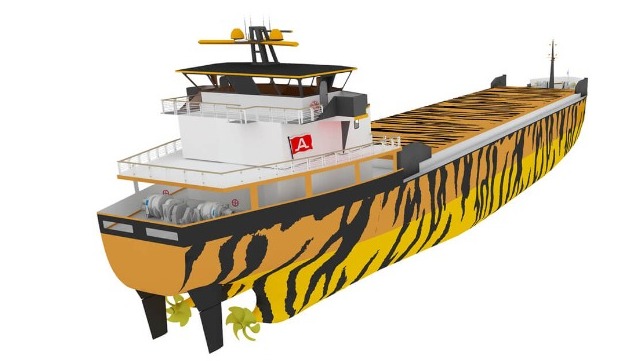Roboship Proceeds with e5 and Mitsubishi Designing Hybrid Battery Ship

Mitsubishi Shipbuilding and Japan’s e5 Labs have agreed to design the next vessel for their prototype Roboship concept for automated, hybrid electric ships. e5, founded by a consortium of four Japanese companies to promote electric propulsion and digitization of ships, developed the platform and last a year ago conducted some of the first proof of concept tests.
The companies have agreed to develop the designs for a 499-ton biomass fuel carrier that will be built by Honda Heavy Industries. Final dimensions will be resolved as part of the design process according to the companies. They expect that this vessel will enter service in April 2023 operating for Aioi Bioenergy Corporation. It will be developed using the Roboship concept which is a standardized platform for hybrid-electric propulsion vessels and it will also be equipped with the Marindows digital platform that utilizes communications and digital technologies to improve the operation of coastal vessels and improve productivity and working conditions aboard ships. Marindows is an offshoot of e5 launched in Mach 2021.
The planned biomass vessel is the second one to be developed on the Roboship platform. Japan’s Asahi Tanker Co. in October 2020 announced the order of two electric-powered bunker vessels to operate in Tokyo Bay. The bunker vessel construction project will be managed by Kawasaki Heavy Industries, with one vessel built at the Koa Sangyo shipyard Marugame, Japan, and the other at Imura Zosen KK in Komatsushima, Japan. They will be powered by large-capacity lithium-ion batteries using an all-electric core energy system. Asahi had targeted as early as 2022 for the introduction of these vessels.
The Roboship platform utilizes a standard system package comprising the hardware for electric propulsion, including propellers, motors, switchboards, storage batteries, and generators, together with the software to safely and efficiently control the equipment. The system is currently able to handle a cargo ship of up to around 749 tons.
According to Mitsubishi, the ships will forego conventional diesel engines in favor of operating on a hybrid system with large-capacity storage batteries and generators to drive the propulsion motors. The adoption of Mitsubishi Shipbuilding’s high-performance twin skeg ship design lowers propulsion horsepower by more than 20 percent, reducing CO2 emissions during cruising, and allowing the ship to navigate completely CO2-free during port operations such as freight loading and unloading, pier docking and undocking, and entering or leaving port. The generators will be capable of switching between eco-friendly fuels including LNG, hydrogen, ammonia, biofuel, and synthetic fuel, allowing all operations, including navigation, to be CO2-free.
Additional benefits of the system include reduced noise and vibration for greater comfort inside the vessel, less need for diesel engine maintenance, and improved steering capabilities that make pier docking and undocking operations easier, reducing the workload on the crew. Further, e5 and Mitsubishi predict that in the future, the mass production of ships equipped with this standardized system will lower costs, which will accelerate the widespread adoption of electric propulsion vessels.
Roboship conducted its proof of concept tests a year ago conducting a successful demonstration of a remote-controlled ship equipped with an automatic collision avoidance algorithm. A series of verification tests were conducted over two days including offshore high-speed broadband communication with the “zero accident” application operating system for the ship and the next generation digital navigation tools. They also experiment with next-generation ship land power management and robot ship operation utilizing AI remote control technology.
